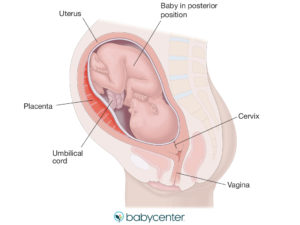Your baby’s position is fundamentally about the relationship between your body and yourself, and your baby and you. Your body gives you clues as to the positioning of your baby, some of which you can begin to learn to interpret yourself, although you may need an experienced and skilled midwife to help. It is the sensations that you feel that guide you through your progress in the exercises. And getting your baby into an optimal position for labor is one of the most important aspects of your relationship with your baby as you approach birth together.
At a time when medicalization of labor can act all too often to reinforce our natural fear and apprehension as we approach labor, when a lack of confidence in our abilities to give birth is paramount, perhaps we should start by trying to get the basics right, starting with the position of our babies. And as with the rest of motherhood, it often takes a lot of hard work to get the fundamentals right.
Defining A Baby in a Posterior Position
“Posterior” usually refers to an “occiput posterior” birth.
Posterior is when the baby is facing out your tummy, not out your back. Anterior (or what medical people consider “normal”) presentation is when the baby is facing your backbone; posterior is when the baby is facing your front. So, if you were looking between your legs as you birthed, a posterior baby would be looking right at you, where an anterior baby would be looking through to your butt. Posteriors are often called “stargazers” or “sunny-side-up” by midwives. Breech is butt-first. Vertex is head down. Many if not most babies who start out labor this way end up rotating during labor to birth occiput anterior or occiput to left or right. About one in four babies is posterior or “sunny-side-up.” This can cause longer labor and severe back pain in labor, although this is not necessarily so!
Posterior Positioning – Signs and Symptoms
In working with many VBAC women, I am amazed at the sheer number of cesarean births attributed to Failure to Progress or CPD, Cephalopelvic Disproportion. In reality, these women have prolonged labors not because of their babies inability to fit through their pelvises, but rather because their babies are posterior.
Pictured above is a view of a posterior baby. Note an indentation in a mother’s her belly button is caused by the gap between the babies arms, the bump below the mother’s belly button, and the babies knees and feet above the mother’s belly button.
Signs of Posterior positioning prenatally
Lots of Prodromal or Braxton-Hicks contractions, often felt as lower back ache or pain that is strong during the day and stops at night. My theory is baby is trying to turn before labor begins, thus the seemingly ineffective contractions.
The feeling that the baby has too many hands and feet, and the moving limbs may be easily felt and seen up front.
Frequent urination due to the baby’s brow pressing against her bladder. Incontinence may be felt as baby wiggles against the bladder, forcing out urine and often it feels like a urinary tract infection because of the constant pressure on the bladder and accompanying backache.
Fetal heart tones may be difficult to detect, or tones are indistinct.
It will be difficult or impossible to feel the babies back, and the head may appear to be engaged.
Signs of Posterior positioning during labor
Along with the symptoms above, the most distinct sign is persistent backache, which even in early labor may be severe enough that the pain of contractions are secondary. As a backache may be present even in normal anterior presentation, it is important that a vaginal examination be done to correctly assess the baby’s position by the fontanels.

